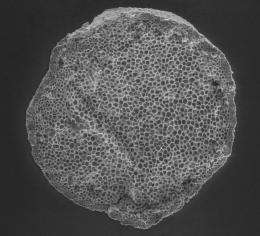Comet cause for climate change theory dealt blow by fungus

(������ƵOrg.com) -- A team of scientists - led by Professor Andrew C Scott of the Department of Earth Sciences at Royal Holloway, University of London - have revealed that neither comet nor catastrophe were the cause for abrupt climate change some 12,900 years ago.
Theories of impacts and their influence on animal extinctions and climate change are receiving increasing attention both in the scientific and popular literature. Despite increasing evidence to dispute the theory, the idea that onset of the Younger Dryas (‘Big Freeze’) climate interval, mega-faunal extinctions, including mammoths, the demise of the North American Clovis culture, and a range of other effects, is due to a comet airburst and/or impact event has remained alive both through written and television media despite growing negative scientific evidence.
One key aspect of this claim centers on the origin of ‘carbonaceous spherules’ that purportedly formed during intense, impact-ignited wildfires. Theorists have used these ‘carbonaceous spherules’ as evidence for their comet impact-theories, but this new study concludes that those supposed clues are nothing more than fossilized balls of fungus, charcoal, and fecal pellets. These naturally-occurring organic materials also date from a period thousands of years both before and after the Younger Dryas period began, further suggesting that there was no sudden impact event.
The research team examined organic residues from some of the proposed sites to investigate the nature of these organic spheres and ‘carbon elongates’ that ranged in size from 1/2 to 2mm (1/10 inch).
Samples from Pleistocene-Holocene sedimentary sequences in the California Channel Islands and other sites show that carbon spherules and elongate forms are common in samples dating to before, during, and well after the 12,900-year time horizon, including from modern samples. Professor Scott says, “Importantly, we were able demonstrate that these organic spheres were found commonly in both modern and ancient sediments and were not just restricted to any particular layer”.
The researchers undertook a series of microscopic studies, including using the advanced Swiss Light Source to probe their internal structure using Synchrotron Radiation X-ray Tomographic Microscopy (SRXTM) to show that carbon spherules have morphologies and internal structures identical to fungal sclerotia (such as Sclerotium and Cenococcum). In investigating these objects, Professor Scott commented: “These spherules had been commonly seen by researchers but little attention was paid to them and so few images existed in the literature. Perhaps it is not surprising that they have been misidentified. Some of the elongate forms described in other pa pers by the impact supporters are arthropod fecal pellets, some almost certainly from termites”.
Professor Scott points out that “we should always have a skeptical attitude to new theories and to test them thoroughly and if the evidence goes against them they should be abandoned”. Professor Pinter, one the report’s authors, from Southern Illinois University, adds, “I think we have reached that stage with the Younger Dryas impact theory”.
The paper, entitled ‘Fungus, not comet or catastrophe, accounts for carbonaceous spherules in the Younger Dryas ‘impact layer’, is published in the journal ‘Geophysical Research Letters’.
Provided by Royal Holloway, University of London



















